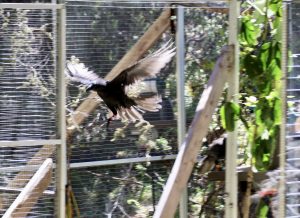Press Release: ADDITIONAL ‘ALALĀ RELEASED INTO NATURAL AREA RESERVE ON HAWAI‘I ISLAND
Posted on Sep 25, 2018 in News & EventsFOR IMMEDIATE RELEASE
Sept. 25, 2018
ADDITIONAL ‘ALALĀ RELEASED INTO NATURAL AREA RESERVE ON HAWAI‘I ISLAND
Five More Birds Take Flight in The Forest
(Hilo, HI) – Tomorrow will mark a year since the successful reintroduction of critically endangered Hawaiian crows into the forests of Hawai’i. Yesterday researchers with The ʻAlalā Project released five more ‘Alalā into the Pu‘u Maka‘ala Natural Area Reserve. These birds will join eleven ‘Alalā already thriving in native forests on the windward slopes of Mauna Loa.
The two females and three males were released from a location within the same reserve. In October, another five birds will be released to make a total of ten in this cohort, to join the released ʻAlalā across the reserve. Prior to these releases, the last wild ʻAlalā were seen in South Kona more than 15 years ago.
“Hearing the voices of the ʻAlalā and seeing them forage in their native habitat after being gone for so long is an incredible feeling,” said Bryce Masuda, Program Manager from the San Diego Zoo Global’s (SDZG) Hawai‘i Endangered Bird Conservation Program (HEBCP). “It is a testament to the resiliency of the birds and the dedication of so many incredible partners that we have come so far.”
After the opening of the release aviary doors, it took 53 minutes for the first bird to finally venture outside. All but the last one flew. It strolled out and quickly joined the others already exploring their new home.
The eleven birds released in 2017 have had a challenging year. Their survival skills were tested through multiple storms including Hurricane Lane, the Kīlauea and Lower East Rift Zone eruptions, and as always seasonal weather patterns. As five new birds join them in the forest, their daily routines continue: foraging on native fruits, eating insects from the bark of trees and agley flying through the ʻōhiʻa-dominated forest.
“The Hawaiian forest, as well as the ʻAlalā, are very resilient,” explained Alison Greggor, PhD., a post-doctoral research associate from the SDZGʻs HEBCP, “They have survived really well over this past year and it will be exciting to see this continue.”
Earlier this year, the ten birds scheduled for release in 2018 were moved to the same flight aviary that housed the 2017 birds. This allows them to acclimate to the sights and sounds of the Hawaiian forest. Each cohort is then transferred to a smaller, release aviary two weeks prior to their release. All of the released birds are tracked and fed routinely by a HEBCP field team. These daily efforts will continue for these and future release birds for as long as needed.
In partnership with the Hawai‘i Dept. of Land & Natural Resources (DLNR), the U.S. Fish and Wildlife Service (USFWS) and others, the bird conservation program reared the ‘Alalā at its centers on Hawai‘i Island and on Maui. In addition to these major funders of the project, cooperative partners include Kamehameha Schools, Three Mountain Alliance, U.S. Geological Survey, and the National Park Service.
In 2016, the ‘Alalā Working Group, a partnership coordinating the reintroduction, initiated a new strategy to return the birds to the forest. Biologists set out to incorporate the birdsʻ personalities and group dynamics along with detailed habitat selection and an innovative approach to training the birds how to avoid predators.
“This strategy is a three-pronged approach; groups are mixed-sex and comprised of birds that affiliate well together. The release sites are quantitatively chosen by experts familiar with the species’ and habitat. Realistic antipredator training is used to evoke fear of their natural predator, the ‘Io”, said Jackie Gaudioso-Levita, the ‘Alalā Project Coordinator.
The ʻAlalā are highly social birds that live in groups and form complex hierarchies. All of this is taken into account when planning a reintroduction. “The numbers of birds released will depend on how many show encouraging behaviors during wild food training and antipredator training, as well as pass the health exams performed by wildlife veterinarians,” said Greggor.
On the day of the bird’s release, an oli, or chant, was offered by members of the ʻAlalā Working Group, honoring the beginning of another chapter of the species’ recovery. Last April, each of these birds was given a Hawaiian name by local school students and the community. Ulu (to grow or inspire), Kūʻokoʻa (freedom), Maikaʻiloa (good fortune), Aumoamoa (to care for), and Kaleo (the voice), are the names of the birds in the first group released this year. “These names hold meaning for the individual birds. Having the students and community working together provides a way for connections to be formed with each other, as well as to the conservation work we are doing” said Rachel Kingsley, Education and Outreach Associate for The ʻAlalā Project.
“Recovering threatened and endangered species is bigger than any one community or agency,” said Michelle Bogardus, USFWS Geographic Team Leader for Maui Nui and Hawaii Island. “It takes everyone working together, and this release is a great example of that. Together we can ensure a healthy future for not only the birds but the forest ecosystem as a whole.”
DLNR Chair Suzanne Case commented, “Although bringing the ‘Alalā back to the wild will take decades of work and perseverance, the people of Hawai‘i and many agencies are dedicated to saving this unique species for the perpetuation of Hawaiian ecosystems.”
# # #

